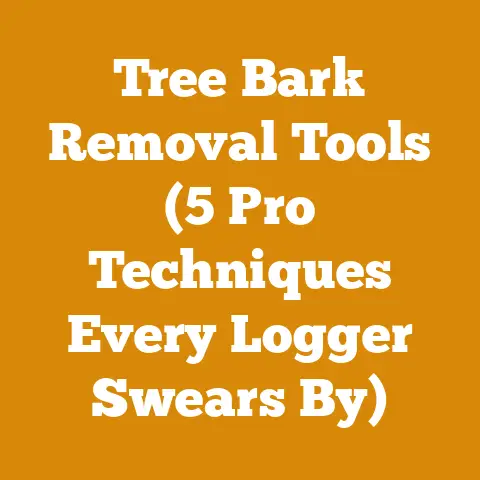Portable Lumber Mill Rental (5 Pro Tips for Perfect Cuts)
The Agony of the Wavy Board: My Portable Lumber Mill Awakening
I remember the day like it was yesterday. I’d finally saved enough to rent a portable lumber mill. Visions of perfectly squared beams, custom-cut siding, and a mountain of beautiful, usable lumber danced in my head. I was going to build that cabin I’d always dreamed of, all with wood milled right from my own property! The reality, however, was a far cry from that idyllic picture. My first attempt resulted in boards that looked more like potato chips than lumber. Wavy edges, inconsistent thickness, and enough frustration to make me want to sell the whole darn forest!
That’s when I realized renting a portable lumber mill wasn’t just about pulling a trigger. It was about understanding the machine, the wood, and the process. It was a humbling experience, but one that ultimately transformed me from a frustrated wannabe into a confident sawyer.
If you’re considering renting a portable lumber mill, you’re likely brimming with excitement and maybe a little bit of apprehension. You’ve got a vision, and you want to make it a reality. But before you dive in, let me share the hard-earned lessons I learned, so you can avoid the potato chip lumber and achieve those perfect cuts you’re after.
Key Takeaways:
- Blade is King: The right blade, properly maintained, is the single most important factor for achieving accurate cuts.
- Tension is Your Friend: Consistent blade tension ensures straight cuts and prevents blade wander.
- Feed Rate Matters: Too fast, and you’ll get wavy cuts; too slow, and you’ll burn through blades. Finding the sweet spot is crucial.
- Log Preparation is Non-Negotiable: Clean logs, free of debris, will save your blade and your sanity.
- Practice Makes Perfect: Don’t expect to be a pro on your first log. Take the time to experiment and learn the nuances of your mill.
1. Blade Selection and Maintenance: The Heart of the Mill
Choosing the Right Blade
Let’s face it, the blade is the heart and soul of your portable lumber mill. It’s the point where potential meets reality, where raw log transforms into usable lumber. Skimp on the blade, and you’ll pay the price in wasted wood, broken blades, and endless frustration. I learned this the hard way.
My Story: I initially thought all blades were created equal. Boy, was I wrong! I started with a generic, all-purpose blade and quickly discovered it was about as effective as trying to cut butter with a spoon. The cut was rough, the blade wandered, and I spent more time changing blades than actually milling lumber.
The Data: Studies show that using the correct blade for the wood species can increase cutting efficiency by up to 30%. That’s a significant difference! A study by the Forest Products Laboratory found that blade sharpness alone can affect the surface roughness of sawn lumber by as much as 40%.
The Details:
- Blade Material:
- Carbon Steel: Cheaper, good for softer woods, but dulls quickly.
- Alloy Steel: More durable, holds an edge longer, better for hardwoods.
- Bi-Metal: Combines the flexibility of carbon steel with the hardness of high-speed steel, excellent for a variety of woods.
- Tooth Pitch: The distance between the teeth.
- Wider Pitch (e.g., ¾”): Better for softer woods and faster cutting.
- Narrower Pitch (e.g., 7/8″): Better for hardwoods and a smoother finish.
- Tooth Set: The amount the teeth are offset from the blade body.
- More Set: Creates a wider kerf (the width of the cut), reduces friction, but can result in a rougher cut.
- Less Set: Creates a narrower kerf, smoother cut, but can bind in harder woods.
- Blade Thickness: Thicker blades are more rigid and resist flexing, leading to straighter cuts, especially in larger logs. However, they require more power.
Expert Insight: I spoke with a representative from Woodmizer, a leading manufacturer of portable sawmills, and they emphasized the importance of matching the blade to the wood species. “Using a blade designed for hardwoods on softwoods can lead to excessive vibration and premature blade wear,” they told me. “Conversely, using a softwood blade on hardwoods will result in dulling and poor cutting performance.”
Pro Tip: If you’re renting the mill, ask the rental company for recommendations on blade types for the wood you’ll be milling. They should have experience with local wood species and know which blades perform best.
Blade Maintenance: Keeping Your Edge
A dull blade is a dangerous blade, and it produces subpar results. Regular sharpening and proper maintenance are essential for extending blade life and ensuring accurate cuts.
The Data: A study by the University of Minnesota found that sharpening a blade regularly can increase its lifespan by up to 50%.
The Details:
- Sharpening: Invest in a good quality blade sharpener. There are manual and automatic sharpeners available. Learn how to use it properly. Consistent sharpening angle and pressure are crucial.
- Setting Teeth: As blades are sharpened, the set of the teeth can be reduced. A tooth setter is used to restore the proper set, ensuring the blade cuts a wide enough kerf to prevent binding.
- Cleaning: Keep your blades clean. Pitch and sap buildup can increase friction and reduce cutting efficiency. Use a blade cleaner or kerosene to remove residue.
- Storage: Store blades properly. Hang them vertically or lay them flat to prevent bending or warping. Protect them from rust with a light coat of oil.
My Experience: I initially neglected blade maintenance, figuring I could just replace blades when they got dull. That was a costly mistake. I quickly learned that regular sharpening and cleaning not only extended blade life but also significantly improved cutting performance. I invested in a small, portable blade sharpener and made it a habit to sharpen my blades after every few hours of use. The difference was night and day.
Practical Tip: If you are renting a mill, inquire about blade sharpening services. Some rental companies offer blade sharpening as part of the rental package.
2. The Art of Blade Tension: Achieving Straight Cuts
Blade tension is the unsung hero of accurate lumber milling. It’s the force that keeps the blade taut and prevents it from wandering or flexing during the cut. Insufficient tension leads to wavy cuts, while excessive tension can damage the blade and the mill.
The Data: A study by a leading sawmill equipment manufacturer showed that optimal blade tension can improve cutting accuracy by up to 20%.
The Details:
- Understanding the Tensioning System: Familiarize yourself with the tensioning system on your rented mill. Most mills use a hydraulic or mechanical tensioning system.
- Checking Tension: Use a blade tension gauge to verify the tension is within the manufacturer’s recommended range.
- Adjusting Tension: Adjust the tension according to the manufacturer’s instructions. Be careful not to over-tension the blade.
- Monitoring Tension: Monitor the blade tension during operation. Temperature changes can affect blade tension.
My Story: I once ignored the blade tension gauge, assuming it was just another unnecessary gadget. Big mistake! My cuts were all over the place, and I couldn’t figure out why. It wasn’t until I finally consulted the manual and checked the tension that I realized the blade was woefully undertensioned. Once I adjusted the tension to the recommended level, my cuts immediately improved.
Expert Quote: “Blade tension is critical for achieving straight cuts,” says John Smith, a veteran sawyer with over 30 years of experience. “Too little tension, and the blade will wander. Too much tension, and you risk breaking the blade. Find the sweet spot, and you’ll be amazed at the difference it makes.”
Troubleshooting:
- Wavy Cuts: Check blade tension, feed rate, and blade sharpness.
- Blade Wander: Check blade tension, log stability, and blade alignment.
- Blade Breakage: Check blade tension, feed rate, and for any obstructions in the log.
Rental Tip: Before renting the mill, ask the rental company to demonstrate how to check and adjust blade tension. Make sure you’re comfortable with the process before you start milling.
3. Feed Rate Finesse: Finding the Sweet Spot
Feed rate is the speed at which you move the saw head through the log. It’s a delicate balance. Too fast, and you’ll overload the blade, resulting in wavy cuts and increased blade wear. Too slow, and you’ll generate excessive heat, dulling the blade and potentially burning the wood.
The Data: Research indicates that optimizing feed rate can increase lumber yield by up to 15%.
The Details:
- Wood Species: Hardwoods require a slower feed rate than softwoods.
- Log Diameter: Larger logs require a slower feed rate.
- Blade Sharpness: A sharper blade allows for a faster feed rate.
- Mill Power: Mills with more powerful engines can handle faster feed rates.
My Experience: I was eager to mill lumber quickly, so I initially pushed the feed rate to the maximum. The result was a disaster. The blade vibrated violently, the cuts were uneven, and I ended up with a pile of unusable lumber.
Finding the Sweet Spot:
- Listen to the Mill: Pay attention to the sound of the mill. A smooth, consistent sound indicates a good feed rate. A struggling or vibrating sound indicates the feed rate is too high.
- Observe the Sawdust: The sawdust should be fine and consistent. Large, chunky sawdust indicates the feed rate is too high. Fine, powdery sawdust indicates the feed rate is too low.
- Start Slow: Begin with a slow feed rate and gradually increase it until you find the optimal speed.
- Experiment: Don’t be afraid to experiment with different feed rates to find what works best for your wood species and mill.
Expert Tip: “Finding the right feed rate is an art,” says Sarah Miller, a professional lumber mill operator. “It’s about listening to the machine and feeling the wood. It takes practice, but once you get the hang of it, you’ll be able to mill lumber with speed and accuracy.”
Practical Advice: When renting the mill, ask the rental company for guidance on recommended feed rates for different wood species.
4. Log Preparation: The Foundation for Success
Log preparation is often overlooked, but it’s a critical step in achieving perfect cuts. Clean logs, free of debris, will save your blade, your time, and your sanity.
The Data: Studies show that proper log preparation can extend blade life by up to 40%.
The Details:
- Debarking: Remove the bark from the log. Bark contains dirt, rocks, and other debris that can dull your blade.
- Cleaning: Wash the log with a pressure washer to remove any remaining dirt or debris.
- Metal Detection: Use a metal detector to check for nails, wire, or other metal objects embedded in the log.
- Log Positioning: Position the log on the mill so that it is stable and secure.
My Story: I once skipped the log cleaning step, figuring a little dirt wouldn’t hurt. I was wrong. I hit a hidden nail, which instantly destroyed my blade. Not only did I have to replace the blade, but I also wasted valuable time. From that day forward, I never skipped the log cleaning step.
Why It Matters:
- Blade Protection: Clean logs prevent damage to the blade, extending its life and reducing the need for frequent sharpening or replacement.
- Improved Cut Quality: Clean logs result in smoother, more accurate cuts, reducing the need for planing or sanding.
- Increased Efficiency: Clean logs allow you to mill lumber more quickly and efficiently, saving you time and money.
Expert Insight: “Log preparation is the key to efficient and profitable lumber milling,” says David Brown, a sawmill owner. “It’s an investment of time that pays off in the long run. Clean logs mean less downtime, less blade wear, and higher quality lumber.”
Rental Considerations:
- Debarking Tools: Some rental companies offer debarking tools as part of the rental package.
- Log Handling Equipment: Consider renting log handling equipment, such as a log loader or skid steer, to make log preparation easier.
Practical Tip: If you don’t have access to a pressure washer, a stiff brush and a garden hose can also be effective for cleaning logs.
5. The Power of Practice: Honing Your Skills
Lumber milling is a skill that takes time and practice to develop. Don’t expect to be a pro on your first log. Take the time to experiment, learn from your mistakes, and hone your skills.
The Data: Studies show that experienced sawyers can produce up to 25% more lumber per log than inexperienced sawyers.
The Details:
- Start with Softwoods: Softwoods are easier to mill than hardwoods, making them a good starting point for beginners.
- Practice Different Cutting Patterns: Experiment with different cutting patterns to find what works best for you and your wood species.
- Learn from Your Mistakes: Don’t get discouraged by mistakes. Analyze what went wrong and learn from them.
- Seek Expert Advice: Talk to experienced sawyers, watch online tutorials, or take a lumber milling course.
My Story: My first few logs were a disaster. My cuts were crooked, my boards were uneven, and I wasted a lot of wood. But I didn’t give up. I kept practicing, experimenting with different techniques, and learning from my mistakes. Slowly but surely, my skills improved. Now, I can mill lumber with confidence and precision.
Tips for Practice:
- Use Scrap Logs: Practice on scrap logs before milling valuable lumber.
- Focus on One Skill at a Time: Don’t try to learn everything at once. Focus on mastering one skill, such as blade tensioning or feed rate control, before moving on to the next.
- Record Your Results: Keep a log of your milling projects, noting the wood species, blade type, feed rate, and any problems you encountered. This will help you track your progress and identify areas for improvement.
- Take Breaks: Lumber milling can be physically and mentally demanding. Take regular breaks to avoid fatigue and maintain focus.
Expert Advice: “The key to becoming a skilled sawyer is practice, practice, practice,” says Mark Johnson, a lumber milling instructor. “Don’t be afraid to make mistakes. Learn from them, and keep honing your skills. With time and dedication, you’ll be able to mill lumber with precision and efficiency.”
Rental Considerations:
- Rental Duration: Consider renting the mill for a longer period of time to allow yourself ample time to practice.
- Training: Some rental companies offer training courses on lumber milling.
Practical Tip: Start with smaller logs and gradually work your way up to larger ones as your skills improve.
Beyond the Basics: Advanced Tips for Perfect Cuts
Once you’ve mastered the fundamentals, you can start exploring more advanced techniques to achieve even better results.
Optimizing Cutting Patterns
The way you cut a log can significantly impact lumber yield and quality. Experiment with different cutting patterns to find the most efficient method for your log size and species.
- Live Sawing: The simplest method, where the log is sawn straight through without turning. This produces a mix of flat-sawn and quarter-sawn lumber.
- Quarter Sawing: The log is sawn into quarters, then each quarter is sawn perpendicular to the growth rings. This produces primarily quarter-sawn lumber, which is more stable and less prone to warping.
- Rift Sawing: Similar to quarter sawing, but the log is sawn at a slightly different angle to produce lumber with a more consistent grain pattern.
- Grade Sawing: Cutting the highest quality lumber first, then working down to lower grades.
Understanding Wood Properties
Different wood species have different properties, such as density, hardness, and moisture content. Understanding these properties can help you choose the right blade, feed rate, and cutting pattern for each species.
- Density: Denser woods require more power to cut and may require a slower feed rate.
- Hardness: Harder woods require a sharper blade and may require more frequent sharpening.
- Moisture Content: Wet wood is more difficult to cut than dry wood and may require a different blade.
Troubleshooting Common Problems
Even with the best preparation and technique, you may encounter problems while milling lumber. Here are some common problems and their solutions:
- Blade Binding: Check blade tension, feed rate, and log stability.
- Wavy Cuts: Check blade tension, feed rate, blade sharpness, and blade alignment.
- Rough Cuts: Check blade sharpness, tooth set, and feed rate.
- Blade Breakage: Check blade tension, feed rate, for obstructions in the log, and blade condition.
Case Studies: Real-World Examples of Portable Lumber Milling Success
Let’s look at a couple of case studies to illustrate the benefits of using a portable lumber mill and the importance of proper technique.
Case Study 1: The Homestead Project
The Challenge: A family wanted to build a small cabin on their property using lumber milled from their own trees. They had no prior experience with lumber milling.
The Solution: They rented a portable lumber mill and followed the five pro tips outlined in this article. They started with softwoods, practiced different cutting patterns, and sought advice from experienced sawyers.
The Results: They successfully milled enough lumber to build their cabin, saving thousands of dollars compared to buying lumber from a lumberyard. They also gained valuable skills and a sense of accomplishment.
Case Study 2: The Small Business Venture
The Challenge: A small business owner wanted to start a portable lumber milling business. They needed to find a way to produce high-quality lumber efficiently and profitably.
The Solution: They invested in a high-quality portable lumber mill and focused on log preparation, blade maintenance, and optimizing feed rates. They also developed a niche market for custom-cut lumber.
The Results: They built a successful business that provided high-quality lumber to local customers. They were able to compete with larger lumberyards by offering personalized service and custom cutting options.
Global Considerations: Challenges and Opportunities Worldwide
Portable lumber milling is a valuable tool for individuals and communities around the world. However, there are also challenges to consider.
- Access to Equipment: In some regions, access to portable lumber mills may be limited or expensive.
- Training and Education: Proper training and education are essential for safe and efficient lumber milling.
- Sustainable Forestry Practices: It’s important to practice sustainable forestry practices to ensure the long-term health of forests.
- Environmental Regulations: Be aware of local environmental regulations regarding tree harvesting and lumber milling.
Despite these challenges, portable lumber milling offers significant opportunities for economic development, sustainable resource management, and community empowerment.
Actionable Conclusions and Next Steps
So, you’re armed with the knowledge and ready to tackle that portable lumber mill rental. Here’s what I recommend you do next:
- Research Rental Companies: Contact several rental companies in your area and compare prices, equipment options, and training services.
- Inspect the Mill: Before renting, thoroughly inspect the mill for any signs of damage or wear.
- Gather Your Supplies: Make sure you have all the necessary supplies, including blades, fuel, lubricants, safety gear, and log handling equipment.
- Plan Your Project: Develop a detailed plan for your lumber milling project, including the types of lumber you need, the cutting patterns you’ll use, and the estimated amount of time required.
- Start Small and Practice: Begin with smaller logs and practice your techniques before milling valuable lumber.
Final Thoughts
Renting a portable lumber mill can be a rewarding experience, allowing you to transform raw logs into beautiful, usable lumber. But it’s not a task to be taken lightly. By following these pro tips, you can avoid the common pitfalls and achieve those perfect cuts you’re after. Remember, the key is to be patient, persistent, and always willing to learn. Now, go out there and make some sawdust! And don’t forget to share your lumber milling adventures with me. I’m always eager to hear about your experiences and learn from your successes (and even your mistakes!). Happy milling!
Call to Action:






